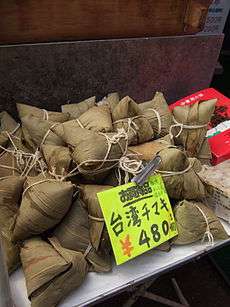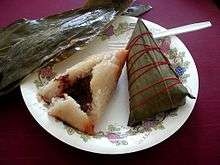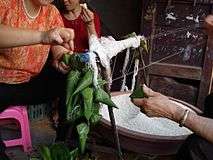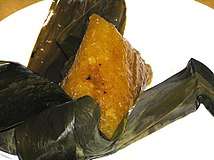Zongzi
Zongzi ([tsʊ̂ŋ.tsɨ]; Chinese: 粽子) (also pronounced as "Zhong" in Cantonese) is a traditional Chinese rice dish made of glutinous rice stuffed with different fillings and wrapped in bamboo leaves,[2] generally of the species Indocalamus tessellatus, sometimes, with reed leaves, or other large flat leaves. They are cooked by steaming or boiling.[3] In the Western world, they are also known as rice dumplings or sticky rice dumplings.
 A bunch of rice dumplings tied together with twine | |
| Alternative names | bakcang, bacang, zang, nom asom, Pya Htote , "Joong", "Doong" |
|---|---|
| Type | Rice cake |
| Place of origin | China |
| Region or state | Chinese-speaking areas |
| Main ingredients | Glutinous rice stuffed with different fillings and wrapped in bamboo or reed leaves |
| Variations | Chimaki, Lotus leaf wrap |
| Similar dishes | Mont phet htok |
| Zongzi | |||||||||||||||
|---|---|---|---|---|---|---|---|---|---|---|---|---|---|---|---|
| Chinese | 粽子 | ||||||||||||||
| |||||||||||||||
| Cantonese name | |||||||||||||||
| Chinese | 糉 | ||||||||||||||
| |||||||||||||||
| Southern Min name | |||||||||||||||
| Traditional Chinese | 肉粽 | ||||||||||||||
| |||||||||||||||
Names
As it diffused to other regions of Asia over many centuries, zongzi became known by various names in different languages and cultures, including Pya Htote in Burmese-speaking areas (such as Myanmar), Nom Chang in Cambodia, Bachang in Indonesia and Khanom Chang in Laos and Ba-chang in Thailand.
Vietnamese cuisine also has a variation on this dish known as Bánh ú tro or Bánh tro.
In Singapore, Indonesia, Taiwan, and Malaysia, zongzi is known as bakcang, bacang, or zang (from Hokkien Chinese: 肉粽; Pe̍h-ōe-jī: bah-chàng), as Hokkien is commonly used among overseas Chinese. Similarly, zongzi is more popularly known as machang among Chinese Filipinos in the Philippines.
In some areas of the United States, particularly California and Texas, zongzi are often known as Chinese tamales.[4][5]
Origins
Zongzi (sticky rice dumplings) are traditionally eaten during the Duanwu Festival (Dragon Boat Festival), which falls on the fifth day of the fifth month of the lunar calendar[2][6] (approximately late-May to mid-June).
A popular belief amongst the Chinese of eating zongzi involved commemorating the death of Qu Yuan, a famous Chinese poet from the kingdom of Chu who lived during the Warring States period.[2] Known for his patriotism, Qu Yuan tried unsuccessfully to warn his king and countrymen against the expansionism of their Qin neighbors. When the Qin general Bai Qi took Yingtu, the Chu capital, in 278 BC, Qu Yuan's grief was so intense that he drowned himself in the Miluo River after penning the Lament for Ying. According to legend, packets of rice were thrown into the river to prevent the fish from eating the poet's body.[2][7] In addition, it is also said that Qu Yuan appeared in a fisherman's dream, saying a flood dragon was in the River, and most of the Zongzi were eaten by the dragon instead of the fishes. He told the fisherman that the dragon feared Argy-wormwood leaves and five-color strings, and as long as those special materials would be added to Zongzi, his body would be protected.[8]
History
It is said that zongzi was born for the poet Qu Yuan. In fact, as early as the Spring and Autumn period, zongzi had appeared. At that time people use gu leaf to wrap shu rice into horn shape, called it "jiao shu" or baked sealed bamboo tube packed with rice, called it "cast tube".[9]
The relationship between zongzi and Qu Yuan, first appeared as story during the early Han dynasty.[10]
At the end of the Eastern Han dynasty, people soaked shu rice with grass and wood ash water, and wrapped shu rice into a quadrangle shape using gu leaves and cooked, called it alkali water dumplings.[11]
Jin dynasty, zongzi was officially as the Dragon Boat Festival food. At this time, the package of rice dumplings in addition to the raw materials of glutinous rice, also added Chinese medicine yizhiren, cooked zongzi called "yizhi zongzi". Rice filled with a variety of meat, chestnut, and other varieties of zongzi began to increase gradually. Zongzi was also used as a gift communication.[12]
In Tang dynasty, the shape of zongzi appeared conical and diamond. "Datang zongzi" was recorded in Japanese literature.
During the Song dynasty, there were many "preserved fruit zongzi". At this time also appeared a pavilion filled with zongzi for advertising, which showed that eating zongzi in the Song dynasty had been very fashionable.[13]
In Yuan and Ming period, the wrapping material had changed from gu leaf to ruo leaf, and then to reed leaves, and filled with materials like bean paste, pine nut kernel, jujube, walnut and so on. The varieties of zongzi were more diverse.
"Ham zongzi" appeared in the Qing dynasty. During the Ming and Qing dynasties, zongzi became auspicious food. At that time, scholars who took the imperial examinations would eat "pen zongzi", which was specially given to them at home, before going to the examination hall. Because it looked long and thin like a brush, the pronunciation of "pen zongzi" is similar to the Chinese word for "pass", which was for good expectation. [9]
Until now, every year in early May of the lunar calendar, the Chinese people will soak glutinous rice, wash the leaves and wrap up zongzi. The types of zongzi are more variety.
Description
The shapes of zongzi vary,[14] and range from being approximately tetrahedral in southern China to an elongated cone in northern China. In the Chiang Kai-shek Memorial Hall in Taipei, plastic mock-ups of rectangular zongzi are displayed as an example of the zongzi eaten by Chiang Kai-shek. Wrapping zongzi neatly is a skill that is passed down through families, as are the recipes. Making zongzi is traditionally a family event of which everyone helps out.
While traditional zongzi are wrapped in bamboo leaves,[15] the leaves of lotus,[16] reed,[17] maize, banana,[18] canna, shell ginger and pandan sometimes are used as substitutes in other countries. Each kind of leaf imparts its own unique aroma and flavor to the rice.
The fillings used for zongzi vary from region to region, but the rice used is almost always glutinous rice (also called "sticky rice" or "sweet rice"). Depending on the region, the rice may be lightly precooked by stir-frying or soaked in water before using. In the north, fillings are mostly red bean paste and tapioca or taro. Northern style zongzi tend to be sweet[19] and dessert-like. Southern-style zongzi, however, tend to be more savory or salty.[19] Fillings of Southern-style zongzi include salted duck egg, pork belly, taro, shredded pork or chicken, Chinese sausage, pork fat, and shiitake mushrooms.
Zongzi need to be steamed or boiled for several hours depending on how the rice is prepared prior to being added, along with the fillings. However, as the modes of zongzi styles have traveled and become mixed, today one can find all kinds of zongzi at traditional markets, and their types are not confined to which side of the Yellow River they originated from.
Fillings


- Mung beans, split and dehulled
- Red bean paste[14]
- Chinese sausage[16]
- Jujube[14]
- Salted chicken fat
- Mushrooms[16]
- Chinese black mushrooms
- Salted eggs
- Ham[16]
- Hard boiled eggs[14]
- Nuts[16]
- Chestnuts[20]
- Cooked peanuts
- Pork[16]
- Conpoy (dried scallops)
- Red-cooked meats
- Chicken[20]
- Yam
- Vegetables
Variations
China
- "Jiaxing zongzi" (嘉兴粽子): It is a kind of zongzi famous in mainland China and named after the city Jiaxing. The filling is typically pork but also can be mung beans, red beans or salted duck eggs.
- Jia zong (假粽): Instead of glutinous rice, balls of glutinous rice flour (so no individual grains of rice are discernible) are used to enclose the fillings of the zongzi. This zongzi are typically smaller than most and are much stickier.
- Jianshui zong (碱水粽): Meaning "alkaline water zong," these are typically eaten as a dessert item rather than as part of the main meal. The glutinous rice is treated with jianzongshui (碱粽水, lye zongzi water, aqueous sodium carbonate), or potassium carbonate, giving them their distinctive yellow color. Jianshui zong typically contain either no filling or are filled with a sweet mixture, such as sweet bean paste. Sometimes, a certain redwood sliver ( 蘇木 ) is inserted for color and flavor. They are often eaten with sugar or light syrup.
- Nyonya chang (娘惹粽): A specialty of Peranakan cuisine, this zongzi are made similarly to southern zongzi. However, the filling is typically minced pork with candied winter melon, ground roasted peanuts, and a spice mix.[21]
- Cantonese jung (广东粽): It is the representative of the southern variety of zongzi, which is more common with fresh meat zongzi with chicken, duck, char siu pork, such as the deployment of stuffing dumplings. Cantonese jungs are small, the front is square, back has a raised sharp Angle, shape like an awl.[22]
- Banlam zang (闽南粽): Xiamen, quanzhou area is very famous for its pork dumplings. Pork zongzi braised pork with pork belly plus mushrooms, shrimp and so on.[23]
- Sichuan zong (四川粽): Sichuan people like to eat spicy food, so they make spicy rice dumplings. They will add sichuan peppercorns, chili powder, sichuan salt and a little preserved pork into the dumplings, wrapped into four-cornered dumplings. Cooked and then roasted, it tastes tender and flavorful.[24]
- Beijing zong (北京粽): They use red dates, bean paste as stuffing, a few also use preserved fruit as stuffing. Cold eating is the local characteristics of zongzi, so also known as cold zongzi, summer if you can put in the refrigerator after the ice to eat, better flavor.[25]
Taiwan
- The northern Taiwanese zongzi (北部粽) are wrapped with husks of Phyllostachys makinoi bamboo (桂竹籜), then steamed; southern Taiwanese zongzi (南部粽) are wrapped with leaves of Bambusa oldhamii (麻竹葉), then boiled.
Making methods
1. Leaves selection: reed leaves zongzi leaves in different regions, with regional disparity varies from place to place, the multi-purpose reed Ye Zhu, or WeiYe, hainan island areas in China also use a lingnan unique plant "Zhong leaf as wrapped in reed leaves, usually triangular shape, cone shape or pyramid shaped. In central China, the leaves of zongzi are mostly quercus leaves, which are rectangular
2. Filling of seasonings: bacon dumplings to the first will be fresh pork with a little MSG, sugar, wine, salt, light soy sauce mix and rub repeatedly until the seasoning into the pork package.
3. The bundle of zongzi: bean paste zongzi should not be tied too tightly, to prevent the rice grains into the bean paste, if not thoroughly cooked will appear sandwich-sheng phenomenon. If the bacon dumplings with fat pork should not tie tight, tight can be appropriate.
4. Zongzi cooking: boiled dumplings must boil water before falling zongzi, water to soak the zongzi noodles, to re-boil after another fire for 3 hours
- Variations of zongzi
 Making (and eating) zongzi
Making (and eating) zongzi- Zongzi tied with leaves
 Jianshui zongzi without fillings
Jianshui zongzi without fillings
See also
References
- Cantodict, 粽 (zung2 zung3 | zong4) : glutinous rice dumpling
- "The Legend of Zongzi (Sticky Rice Wrapped in Bamboo Leaves)". KCET. June 19, 2015. Retrieved November 5, 2016.
- Roufs, T.G.; Roufs, K.S. (2014). Sweet Treats around the World: An Encyclopedia of Food and Culture. ABC-CLIO. p. 81. ISBN 978-1-61069-221-2. Retrieved November 5, 2016.
- https://www.sgvtribune.com/2013/10/14/chinese-tamales-tastily-fete-culture/
- http://luckyrice.com/grandma-hsiangs-chinese-tamales/
- "Zongzi fever". Global Times. June 11, 2015. Retrieved November 5, 2016.
- The origin of tsungtsu Archived May 15, 2007, at the Wayback Machine
- https://artifactsjournal.missouri.edu/2014/03/the-legend-behind-zongzi/
- http://news.youth.cn/sh/201606/t20160606_8090573.htm
- https://www.smithsonianmag.com/arts-culture/the-legends-behind-the-dragon-boat-festival-135634582/
- http://baijiahao.baidu.com/s?id=1602882165235054805&wfr=spider&for=pc
- http://www.xinhuanet.com/local/2017-05/28/c_1121053724.htm
- http://baijiahao.baidu.com/s?id=1604316708397300128&wfr=spider&for=pc
- Schmidt, A.; Fieldhouse, P. (2007). The World Religions Cookbook. Greenwood Press. pp. 27–28. ISBN 978-0-313-33504-4. Retrieved November 5, 2016.
- Thurman, Jim (June 9, 2016). "Where to Find Chinese Zongzi, the Sweet Pork-Filled Tamales Wrapped in Bamboo". L.A. Weekly. Retrieved November 5, 2016.
- Liao, Y. (2014). Food and Festivals of China. China: The Emerging Superpower. Mason Crest. p. pt68. ISBN 978-1-4222-9448-2. Retrieved November 5, 2016.
- Jing, J. (2000). Feeding China's Little Emperors: Food, Children, and Social Change. Stanford University Press. p. 105. ISBN 978-0-8047-3134-8. Retrieved November 5, 2016.
- Mayhew, B.; Miller, K.; English, A. (2002). South-West China. LONELY PLANET SOUTH-WEST CHINA. Lonely Planet Publications. p. 121. ISBN 978-1-86450-370-8. Retrieved November 5, 2016.
- Gong, W. (2007). Lifestyle in China. Journey into China. China Intercontinental Press. pp. 12–13. ISBN 978-7-5085-1102-3. Retrieved November 5, 2016.
- Stepanchuk, C.; Wong, C.C. (1991). Mooncakes and Hungry Ghosts: Festivals of China. China Books & Periodicals. p. 47. ISBN 978-0-8351-2481-2. Retrieved November 5, 2016.
- "Nyonya Rice Dumplings Recipe (Zong Zi) 娘惹粽子 - Huang Kitchen".
- http://baijiahao.baidu.com/s?id=1603322862320313396&wfr=spider&for=pc
- https://baijiahao.baidu.com/s?id=1623524286902938609&wfr=spider&for=pc
- http://baijiahao.baidu.com/s?id=1603149399957728265&wfr=spider&for=pc
- https://www.sohu.com/a/232981414_100155619